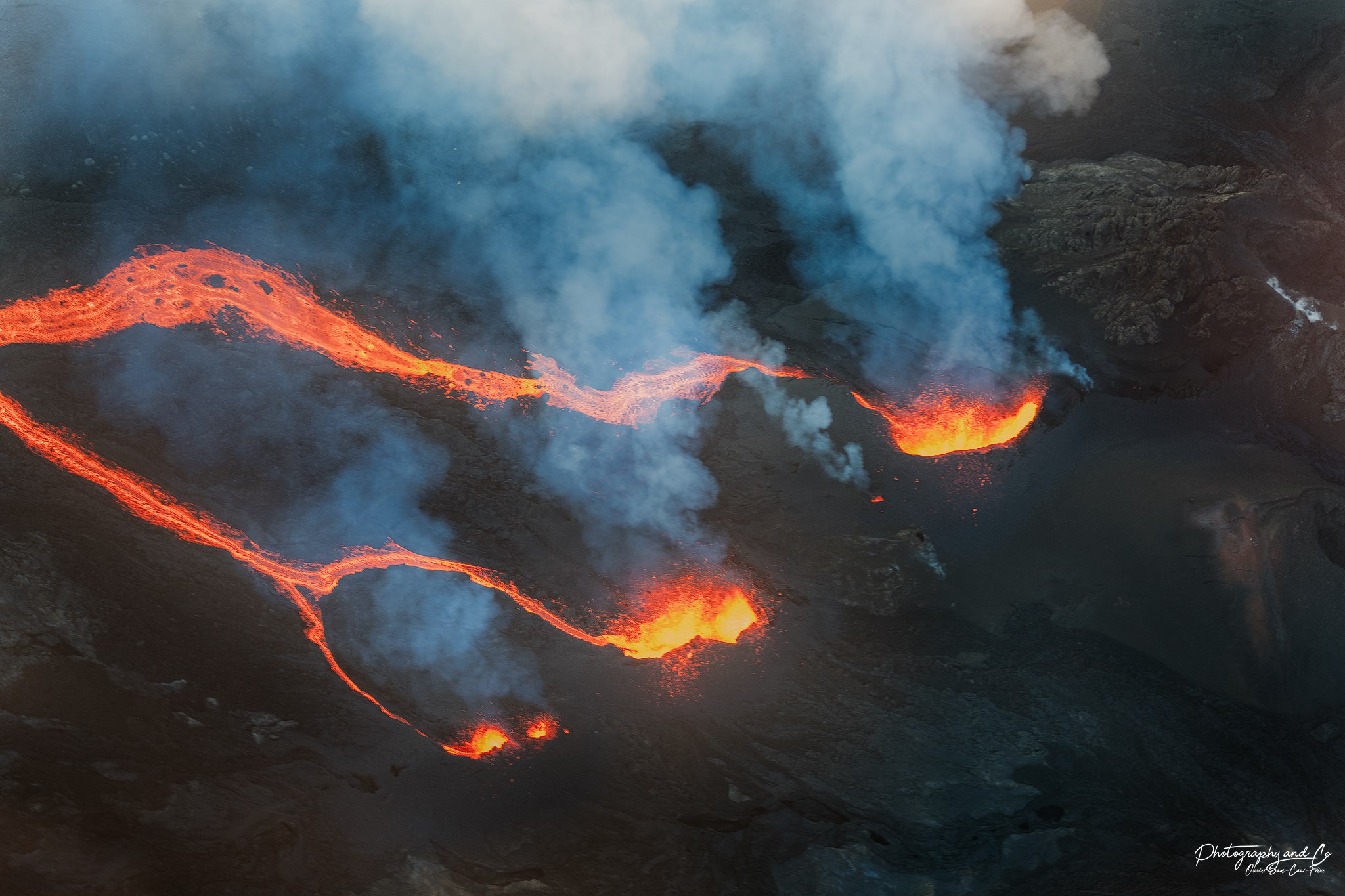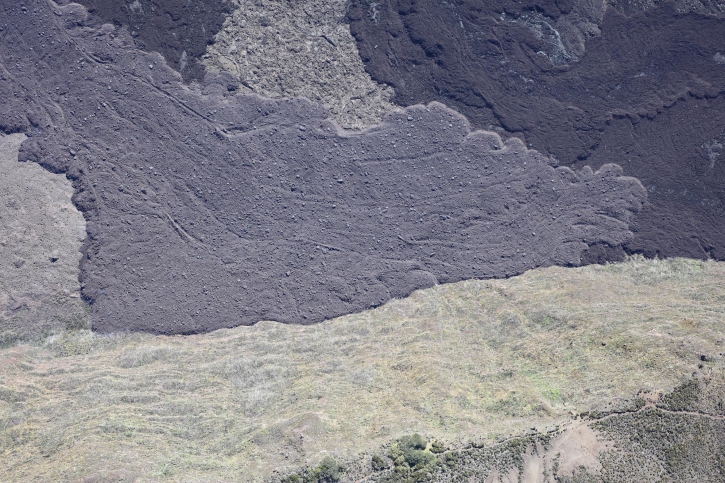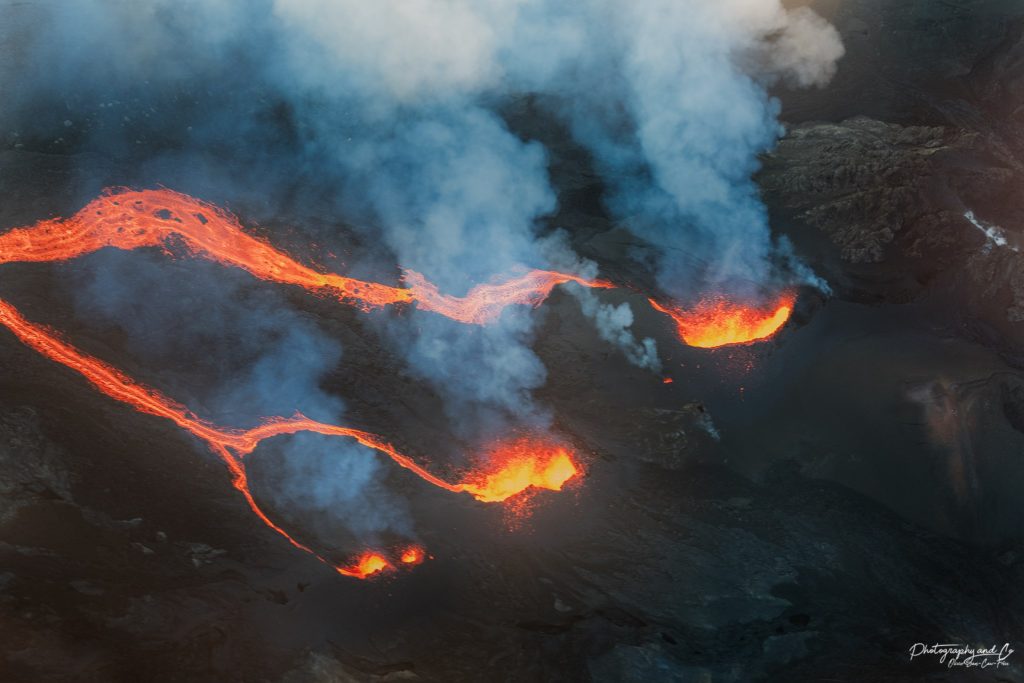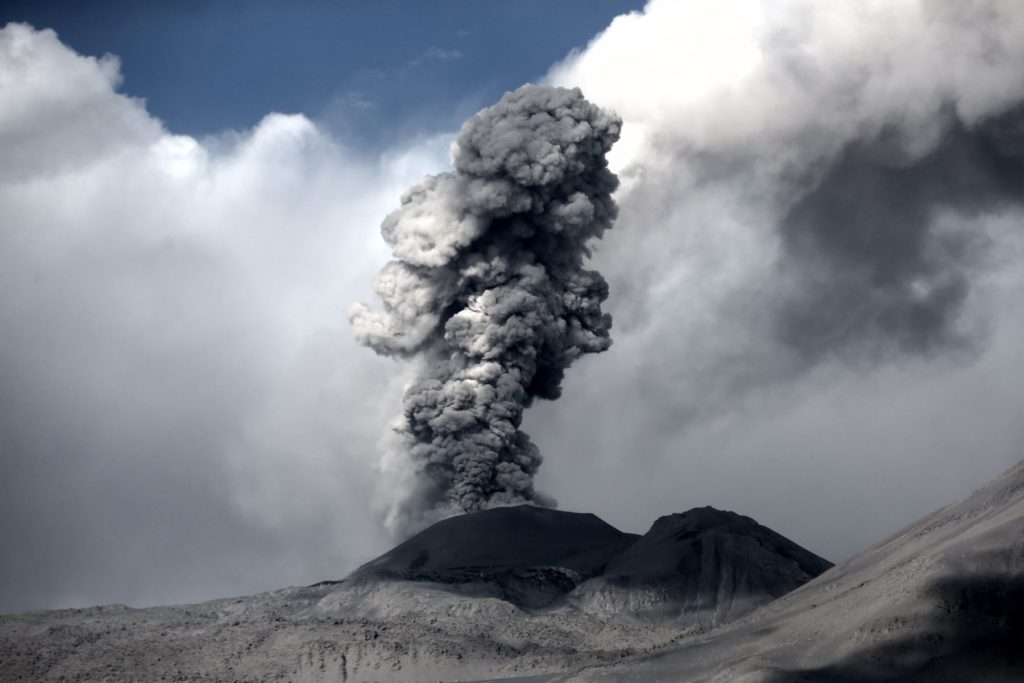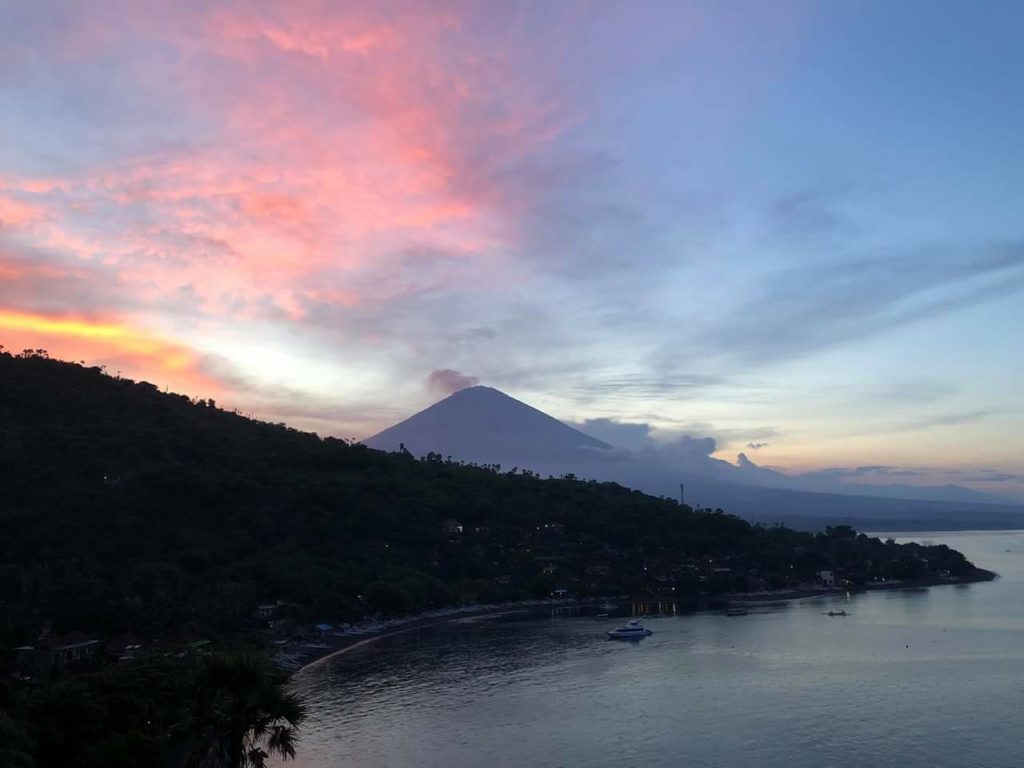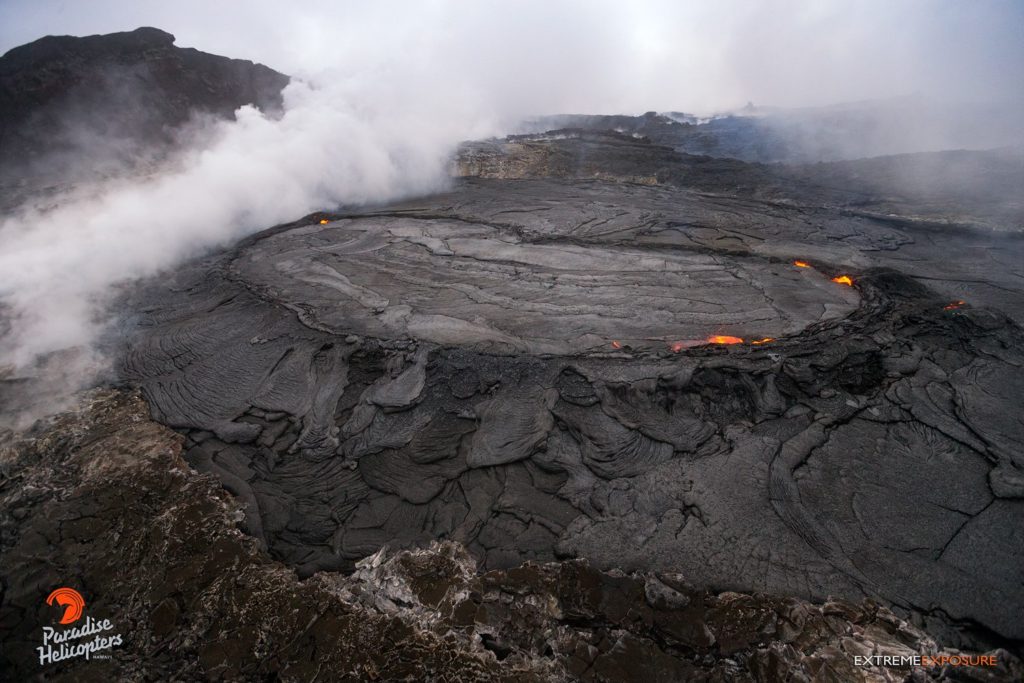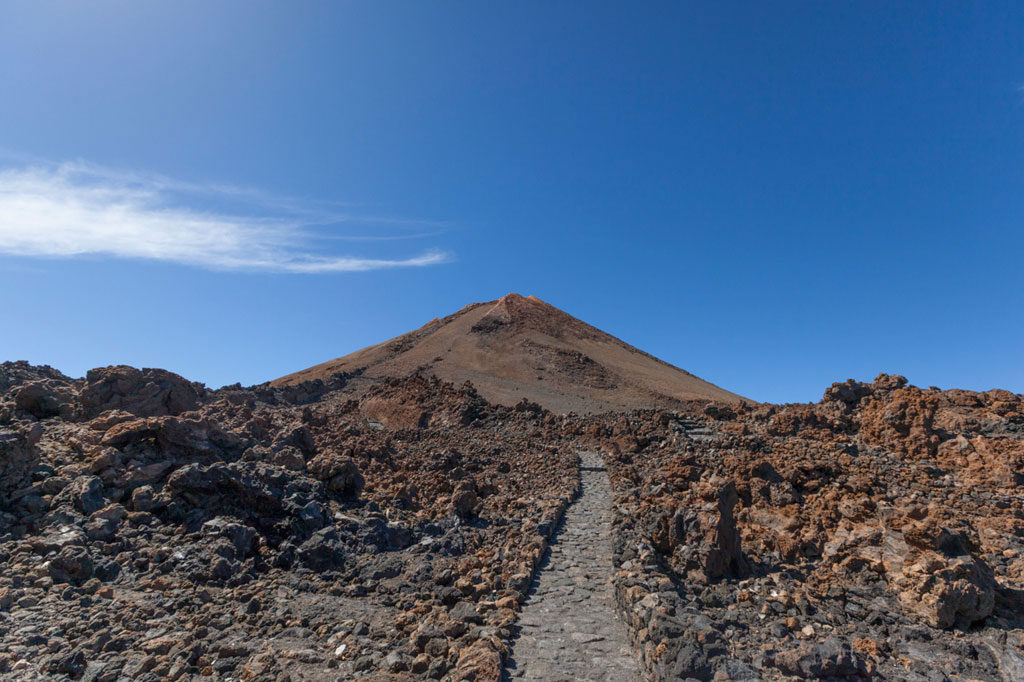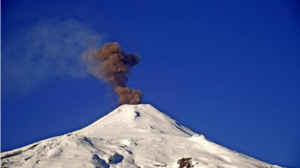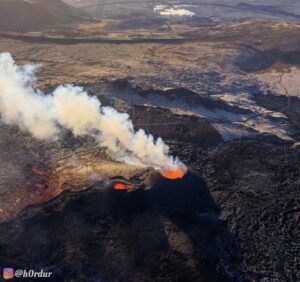May 01 , 2018.
Piton de la Fournaise , La Réunion :
Activity Bulletin from Monday, April 30, 2018 at 16:00 (local time).
The eruption started on April 27, 2018 at 23:50 local time continues. The intensity of the volcanic tremor (indicator of surface eruptive intensity) has remained relatively stable in the last 48 hours (Figure 1). Only a few small amplitude fluctuations have been observed and are related to morphological changes at the eruptive site (volcanic cone building).
Figure 1: Evolution of the RSAM (indicator of the volcanic tremor and the intensity of the eruption) between 20:00 (16h UTC) on April 27th and 15h0 (11h00 UTC) on April 30th on the seismic station of BOR (located at the top) . (© OVPF / IPGP)
– This morning an aerial reconnaissance by a staff of the OVPF / LGSR allowed to make an update on the evolution of the situation.
Three vents are still active south of Crater Rivals (Figure 2).
Figure 2: Shooting of the eruptive site on the 30/04/2018 at 10h20. (© OVPF / IPGP)
The northernmost vent has reduced activity. The two fountains that escape do not seem to exceed fifteen meters in aerial view.
The southernmost vent is a cone that does not exceed five meters high. The aerial view makes it clear that this cone is almost completely closed. Through the small hole located at the top of the lava is still visible inside. It is by this same orifice that sulfur-containing fumaroles escape (common point to the three vents).
Between these two vents a third located in the center is much more active. Formed in length (3 times its height is about 30 to 40 m long), it is occupied by a lake where large bubbles of lava are visible giving fountains when they explode (Figure 2).
During the overflight (10h20 in local time) only this last cone leaked flows of lava. Despite the thick plume, three active sprues were observed. At 10:20 local the two flows arms to the east had not traveled more than 150 m while the one further to the west bypassed the east Cassien Crater and had traveled about 1.2 km.
The aerial observation confirms the elements gathered yesterday according to which the flow had then reached during the day 2.6 km of which 400 m along the southern rampart of Enclos. Observations made on this part of the flow seem to show that it has cooled (at least on the surface). No liquid effusion is visible in his forehead and no smoke is visible in the rampart (Figure 3).
Figure 3: Shooting of the front of the flow at the foot of the wall of the Enclos Fouqué the 30/04/2018 at 10:20. (© OVPF / IPGP)
– A second OVPF team went on site to conduct lava sampling and shooting of the eruptive site for 3D modeling of the site.
– Given the direction of the winds, the gas plume was turned down this day side Piton Bert / Plaine des Sables.
– The surface flows estimated from the satellite data, via the HOTVOLC platform (OPGC – Clermont Ferrand) and MIROVA (University of Turin), recorded today were 4.3 ± 1.5 m3 / s.
– No significant deformation has been recorded in the last 24 hours on the terminal cone.
– Two peak volcano-tectonic earthquakes have been recorded in the past 24 hours under the Piton de la Fournaise building.
Source : OVPF.
Photo : Photography & Co
Sabancaya , Peru :
The explosive activity reached an average of 22 explosions / day, a value similar to that recorded the previous week. The predominance of events associated with fluid movements (Long Period type) and events associated with ash emission (Tremor) continues. The earthquakes that indicate the rise of the magma (type Hybrids) remain weak in number and energy.
The eruptive columns of gas and ash reached a maximum height of about 2000 m above the crater. The dispersion of these materials occurred within a radius of about 30 km, mainly to the northeast and southeast.
No thermal anomalies were recorded according to the MIROVA system. In general, eruptive activity maintains moderate levels.
No major changes are expected in the coming days.
Stay constantly informed by the reports published jointly by the OVI (INGEMMET) and the PGI.
Stay prepared against the descent of any mudslides (lahars).
Do not approach within 12 km of the crater.
Source : IGP
Agung , Indonesia :
VOLCANO OBSERVATORY NOTICE FOR AVIATION – VONA.
Issued: April 30 , 2018
Volcano: Agung (264020)
Current Aviation Colour Code: ORANGE
Previous Aviation Colour Code: orange
Source: Agung Volcano Observatory
Notice Number: 2018AGU22
Volcano Location: S 08 deg 20 min 31 sec E 115 deg 30 min 29 sec
Area: Bali, Indonesia
Summit Elevation: 10054 FT (3142 M)
Volcanic Activity Summary:
Eruption with volcanic ash cloud at 14:45 UTC (22:45 Local)
Volcanic Cloud Height:
Best estimate of ash-cloud top is around 14854 FT (4642 M) above sea level, may be higher than what can be observed clearly. Source of height data: ground observer.
Other Volcanic Cloud Information:
Ash-cloud is moving south west
Remarks:
Seismic activity is dominated by low-frequency earthquakes related to steam and gas emission on the crater.
Source : Magma Indonésie.
Kilauea , Hawai :
19°25’16 » N 155°17’13 » W,
Summit Elevation 4091 ft (1247 m)
Current Volcano Alert Level: WATCH
Current Aviation Color Code: ORANGE
Activity Summary:
Both eruptions continue at Kīlauea Volcano’s summit and East Rift Zone. The summit lava lake has not overflowed the Overlook crater rim in the past 24 hours. Summit tiltmeters continued to record a deflationary signal through the night, and switched to inflationary tilt around 06:30 HST this morning. Tiltmeters and GPS at Puʻu ʻŌʻō cone recorded slight inflation over the last 24 hours. Gas emissions from Puʻu ʻŌʻō are lower than in the past several months. The Episode 61g lava flow remains active within two kilometers (~1.2 miles) of the vent. There is currently no active lava on the pali, the coastal plain, or entering the ocean. The flow does not pose a threat to nearby communities at this time.
Summit Observations:
The lava lake is estimated from webcam views to be 15 m (49 feet) below the new elevated rim of the lava lake. Summit tiltmeters continued to record a deflationary trend over the past day and through the night switching to inflationary tilt signal around 06:30 HST. Tremor amplitude is fluctuating with lava lake spattering and seismometers have recorded a few small earthquakes in the upper East Rift Zone and south part of the caldera. Elevated summit sulfur dioxide emission rates persist.
Puʻu ʻŌʻō Observations:
Overall tilt at Puʻu ʻŌʻō recorded a slight inflationary tilt over the past 24 hours. The crater floor continues to uplift. Webcam views are limited by weather this morning, but overnight thermal images showed no new flows in the crater. Seismicity has not changed significantly. The sulfur dioxide emission rate from the East Rift Zone vents is currently lower than over the past several months and remains significantly lower than the summit emission rate.
Lava Flow Observations:
There is no lava flow activity from the Episode 61g lava flow on the coastal plain or pali, and no lava is flowing into the ocean. Lava flow activity continues on the upper flow field, above the pali and closer to Puʻu ʻŌʻō, and does not pose a threat to nearby communities at this time. Areas of the upper flow field with active lava flows are located within the Kahaualeʻa Natural Area Reserve, which has been closed to the public by DLNR since 2007 due to volcanic hazards.
Source : HVO
Photo : HVO , Bruce Omori , David Ford.
Tenerife, Canary Islands:
Seismic swarm between Tenerife and Gran Canaria.
Since 16:00 UTC (17:00 Canary Time) on April 29, 2018, the Canaria seismic network (Involcan) has detected more than 110 small earthquakes located between the islands of Tenerife and Gran Canaria.
So far, the Involcan seismic monitoring program has been able to locate 70 seismic events whose magnitude was substantially less than M2, with a recorded maximum magnitude of M2.5. Almost all hipocenters are located at depths of about 30 kilometers. The area where this seismic swarm has been recorded is the area where most of the seismicity recorded in the Canaries is normally concentrated.
The red triangles represent the seismic stations installed by Involcan in the islands of Tenerife and Gran Canaria and which are part of the Canaria seismic network (involcan). The yellow circles represent seismic events located and related to this seismic swarm of April 29-30, 2018.
Source : Instituto Volcanologico de Canarias

